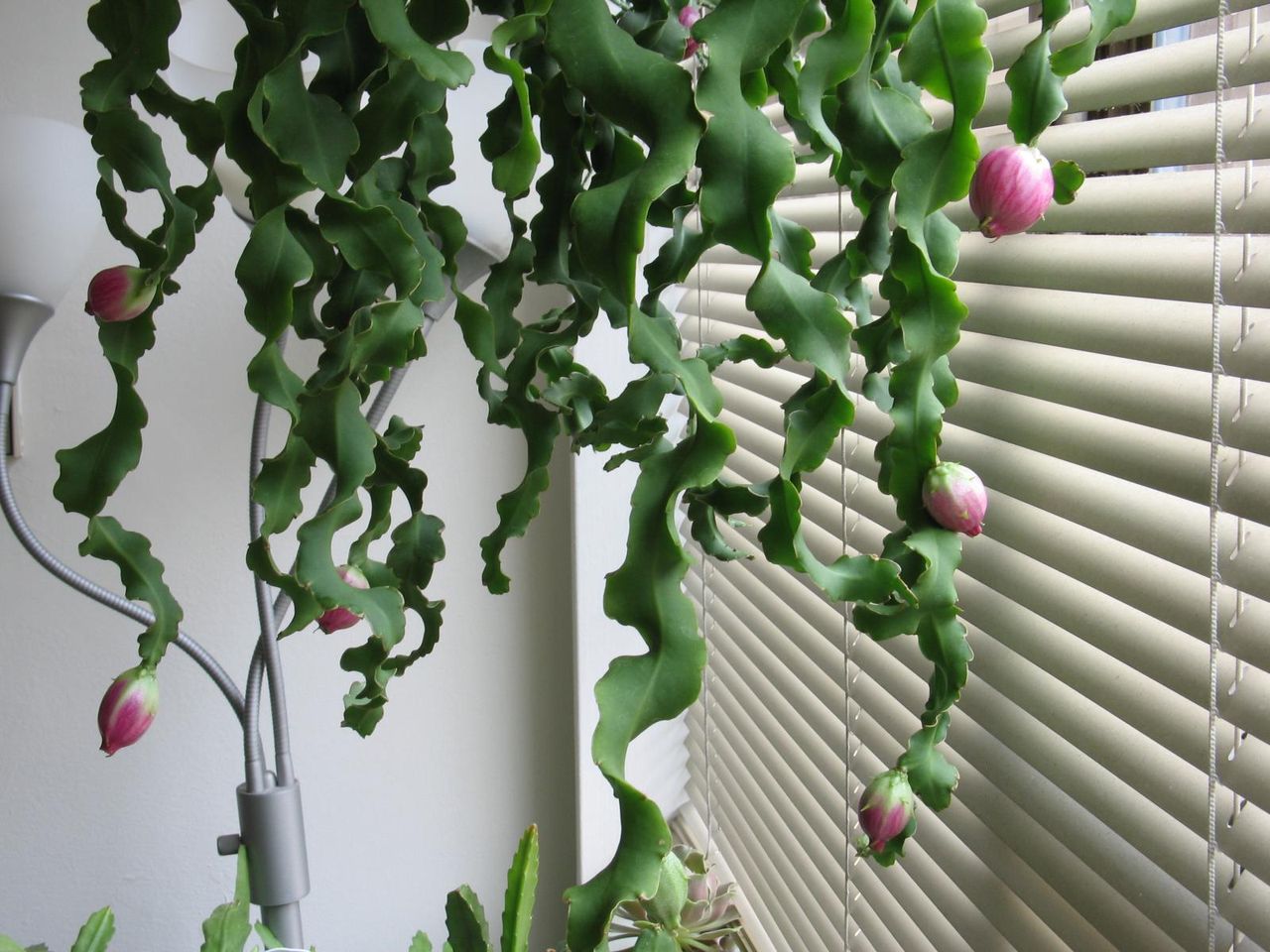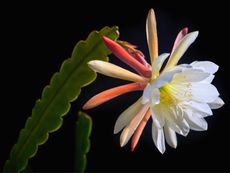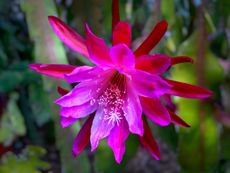Epiphyllum Cactus Info – How To Grow Curly Locks Cactus


Cacti come in a bewildering array of forms. These marvelous succulents have incredible adaptations to survive the inhospitable terrains they generally inhabit. Epiphyllum curly locks is an example of a cactus that uses its stems to capture more moisture and light.
The plant has curly, curved stems which are the result of a mutation of a plant called Epiphyllum guatemalense. The name for this mutated cactus is Epiphyllum monstrosa. If you know someone with the plant, it is easy to learn how to grow curly locks from stem fragments.
Epiphyllum Curly Locks Info
Epiphytic plants live in trees and rock crevasses. The mother of the Epiphyllum cactus, curly locks, was from Guatemala. It was a plant that sprouted one or more abnormal curved stems. These were harvested and cloned to produce the crazy little cactus we propagate today.
These plants are wonderful hanging basket specimens and make quite the conversation piece with their twisted, arching limbs. In nature, curly locks might be growing in a tree crotch or other almost soilless area. Epiphyllums are often called air plants because they do not rely upon terra firma as their growing medium. Curly locks have bright green, twisting stems.
It produces 3 inch (8 cm.) wide white flowers with 6 inch (15 cm.) long tubes that open at night. This is because in nature it is pollinated by moths and bats, and these night animals can see the big white blooms easily. Oval, bright pink seedy fruits form once blooms are pollinated.
These fruits are juicy and edible. The plant is also self-pollinating, and fruits can form even without the intervention of insects and mammals. Epiphyllum plants are often called orchid cacti.
How to Grow Curly Locks
Most Epiphyllum cacti are easy to grow from pieces of the stem. Allow cut pieces to callus for several days then plant into an appropriate medium. Make your own potting mix with three parts commercial potting soil and one part small to medium pumice. If pumice is not available, use bark chips or perlite. The soil must hold moisture but drain quickly.
Gardening tips, videos, info and more delivered right to your inbox!
Sign up for the Gardening Know How newsletter today and receive a free download of our DIY eBook "Bring Your Garden Indoors: 13 DIY Projects For Fall And Winter".
Keep the cutting in low light until it roots. Do not let the medium dry out but don’t let it get soggy either. The orchid cactus cutting needs to be installed 1 or 2 inches (2.5-5 cm.) below the soil at a serration. Rooting should occur in a couple of weeks and after that the plant really takes off, producing new curled stems.
Curly Locks Orchid Cactus Care
The biggest danger is overwatering. The cactus needs to have moist roots at all times, but they should not be sitting in a dish of water. Make sure the top one third of the soil is dry before watering. In late winter, expose the cactus to cooler temperatures to promote spring flowering. Keep them in the basement or a garage for a couple of weeks to spur bud formation.
The other biggest danger when raising Epiphyllums is lighting. Consider that these plants grow in thick forests in the understory and are used to dappled light at best. Just like any plant, they need light but should be protected from bright midday light. Morning sun is preferable with indirect light the rest of the way. If you find a spot where the cactus is happy, make sure to leave it there, as they do not like change.
Use a 10-10-10 fertilizer diluted weekly during the growing season. In February, feed the plant with a 2-10-10 to promote blooming. Repot every seven years or so, but be warned, the plant only blooms when it is pot bound. It might be best to wait and see if you get flowers before giving the plant a new home.

Bonnie Grant is a professional landscaper with a Certification in Urban Gardening. She has been gardening and writing for 15 years. A former professional chef, she has a passion for edible landscaping.
-
 Grow Limelight Hydrangea Shrubs For Green Themed Displays And Brilliant Borders
Grow Limelight Hydrangea Shrubs For Green Themed Displays And Brilliant BordersIf you're a panicle hydrangea lover in search of flamboyant, long-lasting florals, knowing how to grow Limelight hydrangea shrubs will ensure gorgeous green blooms
By Mary Ellen Ellis
-
 How To Reuse Plastic In Your Garden: 9 Clever Ways To Keep Waste Out Of The Landfill
How To Reuse Plastic In Your Garden: 9 Clever Ways To Keep Waste Out Of The LandfillRepurposing is a great way to reuse plastic in the garden. We have gathered some clever ideas about ways to reuse plastic that are helpful for gardeners.
By Teo Spengler
-
 Epiphyllum Varieties: Types Of Cactus Orchid Plants
Epiphyllum Varieties: Types Of Cactus Orchid PlantsEpiphyllum are the gems of the cactus world. Commonly called orchid cactus, they produce absolutely stunning flowers. Click to learn more.
By Bonnie L. Grant
-
 Epiphyllum Plant Care: Tips For Growing Epiphyllum Cactus
Epiphyllum Plant Care: Tips For Growing Epiphyllum CactusLook into growing some of the ten species of epiphyllum, or orchid cactus. Find them in garden centers or online, and grow them in much the same way you’d grow an orchid.
By Bonnie L. Grant
-
 Epiphyllum Seed Pods: What To Do With Pods On Epiphyllum Plant
Epiphyllum Seed Pods: What To Do With Pods On Epiphyllum PlantEpiphyllum cactus have lovely flowers, which turn into a chubby little fruit filled with tiny seeds. Growing Ephiphyllum seeds will take some patience but it is a rewarding endeavor that will give you more of these beautiful plants. This article will help.
By Bonnie L. Grant